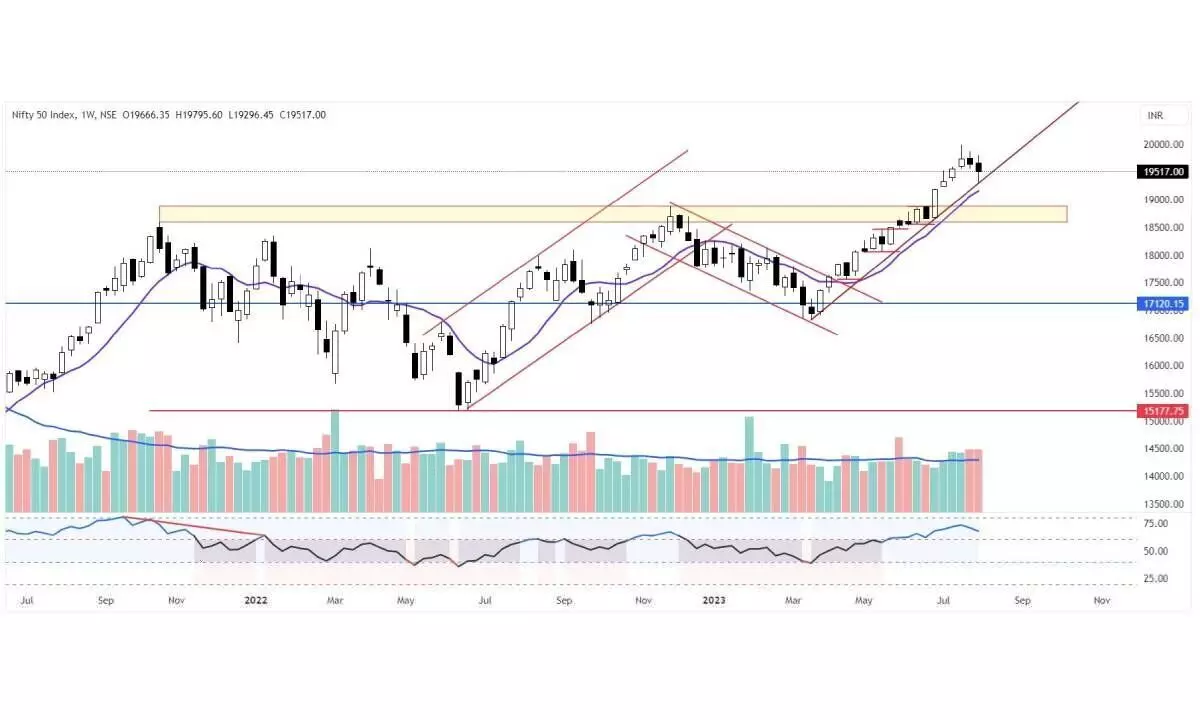Lower VIX may trigger profit-booking
Index awaits a trend reversion by ending counter-trend
image for illustrative purpose

The domestic equities were very volatile during the last week, and the benchmark indices traded in the extended range. NSE Nifty traded in 499.15 points range during the week and finally settled with 134.30 points or 0.68 per cent decline. The BSE Sensex also declined by 0.66 per cent. The Nifty Mid-cap and Small-cap indices advanced by 0.73 per cent and 0.84 per cent, respectively. Only Nifty IT and the Pharma indices were the gainers, with 3.21 per cent and 1.86 per cent, respectively. Nifty Realty declined by 4.23 per cent, and PSU Bank, down by 4.05 per cent, are the top losers. The market breadth is mostly positive during the week. In the four trading sessions in the current month, the FIIs sold Rs2,844.47 crore, and the DIIs bought Rs3,129.26 crores worth of equities.
After 18 weeks, the Nifty closed below the previous week’s low. It closed at three weeks low. The decline with a higher volume in the last two weeks indicates a clear distribution. The Nifty is holding four distribution days currently. It closed below the 20DMA decisively. As we expected, the mean reversion is completed. Now, the question is, Will the Nifty end its counter-trend and resume the uptrend? During the last week, it declined below the 4th July low and formed a low. It has broken the rising channel on the downside, but it went back into the channel on Friday. This pullback is normal as long as it trades below the 20DMA.
Last week we discussed that the overstretched market would enter into consolidation as long as it trades below the 27th July high of 19,867 points. The pullback is limited to just one day (Monday). It failed to break out the Flag pattern on the upside on Tuesday, though it opened above the previous day’s high. The next two days of sharp fall resulted in a downside breakout. For the first time since the March low, the Nifty declined by 3.48 per cent. All the prior declines were limited to less than two per cent. As we forecast, the fall is impulsive in nature. The positive aspect is that the decline is once again limited to three days and back into the downward Flag pattern. As mentioned above, a close above 19,626-660 levels can be considered a failed breakdown.
Interestingly, the broader market indices continued to outperform. The Nifty gained by 18.80 per cent from the March lows, and the Mid-cap and Small-cap indices gained by 29.74 per cent and 35.98 per cent, respectively. Another interesting point is the FIIs have been selling equities since the 21st July, and the market topped out on the 20th July. This co-incident has precedence. When the Nifty formed new highs in October 2021 and November 2023, the FIIs began to sell the equities. After hitting the lifetime high of 19,992 points on 20th July, the Nifty opened a gap down the next day, which acted as resistance on 1st August. This is the reason the 19,800 points is the strong resistance. Only above this level the Nifty will gain the strength to move higher to the new highs.
The VIX is still at historically lower levels, still a threat to the trend. A small spike in VIX will lead to an impulsive move in the index, which was evident last week. With Friday’s bounce, the VIX is back to below 11 levels. As long as the VIX sustains at lower levels, the market is vulnerable to profit taking on every rise. The RBI policy scheduled next week on a weekly expiry may witness a spike in volatility. For the next week, the 19,140-660 zone will be crucial support and resistance. Focus on money management, and protect the profits on the table. Stock specific activity will continue.
(The author is Chief Mentor, Indus School of Technical Analysis, Financial Journalist, Technical Analyst, Trainer and Family Fund Manager)

